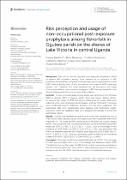| dc.description.abstract | The use of non-occupational post-exposure prophylaxis (nPEP)
to prevent HIV acquisition among those exposed as an approach to HIV
prevention has expanded in Uganda. Although there are increased eorts to avail
nPEP services among most at-risk populations, the usage of nPEP medicines
remains low. Therefore, this study examined the risk perception and usage
of non-occupational post-exposure prophylaxis (nPEP) among fisherfolk in the
Ggulwe fishing parish, Bussi sub-county, Wakiso district.
A cross-sectional study among adults was carried out from October
2020 to January 2021 in Ggulwe parish, Bussi sub-county, Wakiso district,
to examine the usage of nPEP and factors influencing the usage. Data were
collected using semi-structured questionnaires, and key informants’ interviews
were conducted among healthcare providers and the local leadership. The
quantitative data were summarized using bivariate and multivariate logistic
regression, while the qualitative data were analyzed thematically to enrich the
quantitative results.
Overall, 248 fisherfolk encountered an event that required the use of
nPEP, and of these, 55/248 (22.2%) were able to use nPEP to prevent them from
acquiring HIV. The usage of nPEP among adults in the Bussi sub-county, Wakiso
district, was associated with not knowing that HIV can be prevented using nPEP
medicines (AOR:0.1, 95% CI 0.03–0.36, p < 0.001), lack of knowledge of the
existence of nPEP (AOR: 0.3, 95% CI 0.13–0.76, p = 0.01), the perception that
nPEP can eectively prevent HIV infection after exposure (AOR 0.0586, 95% CI:
0.0177–0.1944, p < 0.001), and the community’s opinion aecting the willingness
to take nPEP (AOR 0.1924, 95% CI: 0.0380–0.9727, p = 0.0462).
The usage of nPEP among fisherfolk was low (22.2%). The low usage
of nPEP was associated with a lack of knowledge and awareness about nPEP.
This eort to improve the usage of nPEP should include community sensitization
and HIV infection prevention using nPEP to raise awareness about HIV infection
exposures and the risk of HIV infection during non-occupational exposur | en_US |


